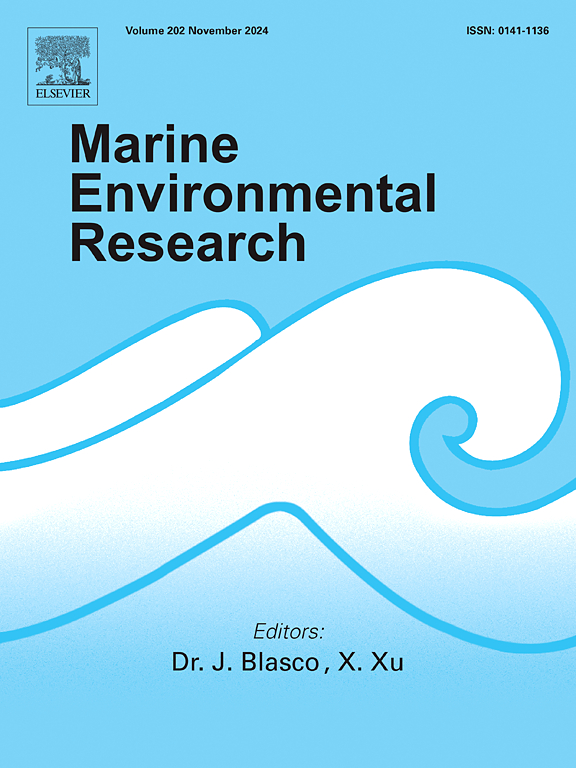Composition of inshore ichthyoplankton community in the Canary islands from a spatial and seasonal perspective
IF 3
3区 环境科学与生态学
Q2 ENVIRONMENTAL SCIENCES
引用次数: 0
Abstract
Early life stages of fish are insufficiently studied in most regions around the globe, and consequently, there is an important gap in knowledge on the life cycle of most teleosts. In the Canary Islands (Eastern Central Atlantic), most studies on ichthyoplankton communities are based on traditional net tows in open waters that provide information about early larval stages of pelagic species in the area, while nearshore benthic fish remain highly understudied. In this study, light traps were employed for the first time to assess post-larval stages of neritic fish in this archipelago. A two-year survey was carried out to collect nearshore fish larvae every 6 months at 11 localities from El Hierro, Tenerife and Lanzarote. A total of 3940 fish larvae classified into 13 orders, 28 families and 44 species were collected. These results provide a wide description of the composition of the inshore ichthyoplankton off the Canary Islands, across islands and seasons. Main environmental factors (SST, sea floor orography, oceanographic phenomena …) influencing the population dynamics of this community are discussed. Additionally, the ichthyoplankton assemblages were assessed from the intra-annual perspective, analyzing the species composition and abundances by months and seasons, and providing new insights into reproduction cycles of many common benthic fishes at shallow marine ecosystems of the islands. This study is important to further understand the life cycles of some of the most common fish species in the Canary Islands, unraveling main environmental factors that affect the success of their offspring that sustain populations.
从空间和季节角度看加那利群岛近岸鱼类浮游生物群落的构成
全球大多数地区对鱼类早期生命阶段的研究不足,因此,对大多数远洋鱼类生命周期的了解存在重大差距。在加那利群岛(中东部大西洋),对鱼类浮游生物群落的大多数研究都是基于开放水域的传统网拖,这些网拖提供了该地区中上层鱼类早期幼虫阶段的信息,而对近岸底栖鱼类的研究仍然严重不足。在这项研究中,首次使用了灯光诱捕器来评估该群岛中黑线鳕的后期阶段。这项调查为期两年,每 6 个月在埃尔希耶罗、特内里费和兰萨罗特的 11 个地点收集近岸鱼类幼虫。共收集到 3940 条鱼类幼体,分为 13 目 28 科 44 种。这些结果广泛描述了加那利群岛近海鱼类浮游生物在不同岛屿和不同季节的组成情况。讨论了影响该群落种群动态的主要环境因素(海温、海底地形、海洋现象......)。此外,还从年内角度评估了鱼类浮游生物群落,分析了不同月份和季节的物种组成和丰度,为了解群岛浅海生态系统中许多常见底栖鱼类的繁殖周期提供了新的视角。这项研究对于进一步了解加那利群岛一些最常见鱼类的生命周期,揭示影响其后代成功维持种群的主要环境因素非常重要。
本文章由计算机程序翻译,如有差异,请以英文原文为准。
求助全文
约1分钟内获得全文
求助全文
来源期刊

Marine environmental research
环境科学-毒理学
CiteScore
5.90
自引率
3.00%
发文量
217
审稿时长
46 days
期刊介绍:
Marine Environmental Research publishes original research papers on chemical, physical, and biological interactions in the oceans and coastal waters. The journal serves as a forum for new information on biology, chemistry, and toxicology and syntheses that advance understanding of marine environmental processes.
Submission of multidisciplinary studies is encouraged. Studies that utilize experimental approaches to clarify the roles of anthropogenic and natural causes of changes in marine ecosystems are especially welcome, as are those studies that represent new developments of a theoretical or conceptual aspect of marine science. All papers published in this journal are reviewed by qualified peers prior to acceptance and publication. Examples of topics considered to be appropriate for the journal include, but are not limited to, the following:
– The extent, persistence, and consequences of change and the recovery from such change in natural marine systems
– The biochemical, physiological, and ecological consequences of contaminants to marine organisms and ecosystems
– The biogeochemistry of naturally occurring and anthropogenic substances
– Models that describe and predict the above processes
– Monitoring studies, to the extent that their results provide new information on functional processes
– Methodological papers describing improved quantitative techniques for the marine sciences.
 求助内容:
求助内容: 应助结果提醒方式:
应助结果提醒方式:


